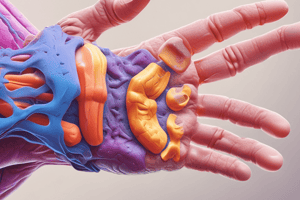Podcast
Questions and Answers
What is the typical pattern of joint involvement in rheumatoid arthritis?
What is the typical pattern of joint involvement in rheumatoid arthritis?
- Symmetric inflammatory polyarthritis involving more than 3 joints (correct)
- Symmetric inflammatory polyarthritis involving less than 3 joints
- Asymmetric polyarthritis with predominant involvement of DIP joints
- Asymmetric inflammatory polyarthritis
Which of the following symptoms is a characteristic feature of affected joints in rheumatoid arthritis?
Which of the following symptoms is a characteristic feature of affected joints in rheumatoid arthritis?
- Pain localized solely to the DIP joints
- Morning pain and/or stiffness lasting over 60 minutes (correct)
- Acute, sudden onset of joint pain
- Pain that worsens with joint movement
What defines the 'gelling phenomenon' in rheumatoid arthritis?
What defines the 'gelling phenomenon' in rheumatoid arthritis?
- Improvement of symptoms with prolonged inactivity
- Worsening of symptoms with prolonged inactivity (correct)
- Joint pain that worsens with movement
- Joint pain that improves with rest
Which hand deformity is NOT typically associated with rheumatoid arthritis?
Which hand deformity is NOT typically associated with rheumatoid arthritis?
What is a significant risk associated with cervical spine involvement in chronic rheumatoid arthritis?
What is a significant risk associated with cervical spine involvement in chronic rheumatoid arthritis?
Which joints are typically spared in rheumatoid arthritis?
Which joints are typically spared in rheumatoid arthritis?
For management, which aspect is critical when assessing disease activity in rheumatoid arthritis?
For management, which aspect is critical when assessing disease activity in rheumatoid arthritis?
Which laboratory test is most informative in confirming a diagnosis of rheumatoid arthritis?
Which laboratory test is most informative in confirming a diagnosis of rheumatoid arthritis?
Which type of therapy is commonly utilized in the treatment of rheumatoid arthritis?
Which type of therapy is commonly utilized in the treatment of rheumatoid arthritis?
What is considered an atypical presentation of rheumatoid arthritis that can complicate diagnosis?
What is considered an atypical presentation of rheumatoid arthritis that can complicate diagnosis?
Flashcards are hidden until you start studying
Study Notes
Differential Diagnosis
- Rheumatoid Arthritis (RA) must be distinguished from symmetrical seronegative spondyloarthropathies.
- Severe RA can resemble a type of psoriatic arthritis known as "arthritis mutilans."
Diagnosis Criteria
- A positive serology is now a requirement for RA diagnosis.
- Joint involvement scoring:
- 1 large joint: 1 point
- 2-10 large joints: 2 points
- 1-3 small joints: 1 point
- 4-10 small joints: 2 points
Radiological Findings
- Classic radiographic signs include:
- Periarticular osteopenia
- Joint space narrowing
- Juxtaarticular erosions
- Erosions of the ulnar styloids
- Early signs often first seen in the feet, particularly at the fifth metatarsophalangeal joint.
Laboratory Tests
- Rheumatoid Factor (RF):
- Antibodies targeting the Fc region of IgG; poor specificity for RA.
- Associated conditions: SLE, Sjögren's syndrome, viral infections (HCV, EBV, etc.).
- Only about 50% of RA patients are RF positive at onset; up to 20% may remain negative.
- High titers can indicate an aggressive disease course.
- Anti-Cyclic Citrullinated Peptide (anti-CCP):
- More specific for RA (90%-95%) but less sensitive than RF.
- Positive results suggest increased risk for radiographic progression.
- Serum markers:
- Elevated ESR and CRP, though not sensitive or specific for RA.
- Common occurrence of anemia of chronic disease.
- Normal or increased platelet count, contrasting with low counts in SLE.
- Synovial fluid analysis shows sterility with a high neutrophil count in uncomplicated cases.
Management Strategies
- Assess disease activity using history, physical examination, and standardized Disease Activity Score.
- Treatment based on disease severity:
- Low activity: Initiate DMARD monotherapy.
- High activity: Consider combination DMARD therapy or anti-TNF therapy.
- Early initiation of DMARDs is critical to reduce damage and disability.
- During pregnancy, prednisone and hydroxychloroquine are recommended anti-inflammatory agents.
Clinical Features
- Articular Manifestations:
- Symmetric inflammatory polyarthritis involving more than three joints, typically affecting:
- MCP, PIP, wrist, elbow, knee, ankle, MTP joints.
- Characteristic symptoms include:
- Morning pain or stiffness lasting more than 60 minutes for at least six weeks.
- Symptoms improve with movement but worsen with inactivity (Gelling phenomenon).
- Presence of erythema, warmth, or swelling in joints.
- Notable hand deformities include ulnar deviation at MCPs, swan neck, and boutonniere deformities.
- Symmetric inflammatory polyarthritis involving more than three joints, typically affecting:
- Spinal Involvement:
- RA may affect the cervical spine, with risk of asymptomatic C1-C2 (atlanto-axial) subluxation.
- Important to perform cervical spine x-ray before tracheal intubation to evaluate for potential complications.
Studying That Suits You
Use AI to generate personalized quizzes and flashcards to suit your learning preferences.




